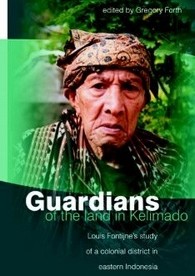Guardians of the land in Kelimado
Title : Guardians of the land in Kelimado
By :- Louis Fontijnes edited by Gregory Forth
Published :- KITLV press, Leiden 2004; Paperback (250 pages)
Outline;- Louis Fontijnes study of a colonial district in eastern Indonesia” (Flores) edited by Gregory Forth, the long introduction provides an insight to village respect. “Prestige was required because real credit to the community naturally brings acknowledgement by the community”. Gregory Forth also provides an outline of the first Dutch colonization wherein they sought out a person that could speak Malay from one of the largest and most influential clans and appointed him as their representative, effectively raising his stature significantly. Unfortunately a rival clan felt this honor and status should have been to them, and so a long lasting conflict was born.
LousiFontijne’s final chapter is on the decline of the traditional tribal authority and structure with the onset of the new Dutch administration, and Christianization. Although his study is set in the 1940’s there are a number of observations that may also apply to today’s era of Regional Autonomy. The introduced Dutch authority system of kampong being subordinate to the district that in turn was controlled by the region was essentially monarchical, replacing small autonomous village councils of collective authority. The removal of the justice system from the village elders to the Dutch government “enabled people to withdraw from the deliberations of the traditional leaders, and turn to the new judicial authority instituted for this purpose, has radically undermined the traditional authority.” “Collectively administering land disputes with traditional communities…lost importance and urgency since, owning to the pacification of the territory, the implicit threat of war over disputed maters began to disappear.” The importance of having a justice system that brings peace and prosperity is fundamental to the acceptance from the community

